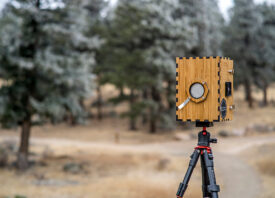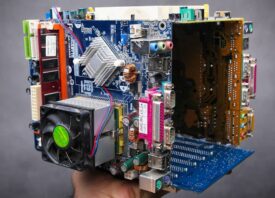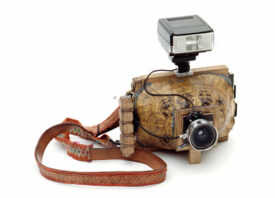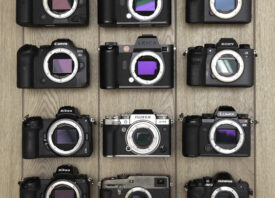Search this site
The Coolest DIY Cameras and Tips from the Builders

When Justin Quinnell‘s neighborhood first replaced metal trash cans with massive plastic ones with wheels (circa 1989), his first thought was, “Can I turn this into a camera?” The answer, it turned out, was yes. The Wheelie Bin Camera, as he named it, was ultimately bought by the Royal Photographic Society. Today, it’s one of hundreds of DIY cameras in Quinnell’s oeuvre.
Decades later, a thriving community of builders, inventors, and tinkerers are using everything they can get their hands on to make DIY cameras: old camera parts, 3D-printed parts, cardboard boxes, and leaves. Starting with the pinhole cameras and moving through the medium- and large-format cameras and finally into a scanner camera, we take a look at some of our favorite creations.
“There was a time when everyone had to make their own cameras,” Quinnell tells us. “Creating your own liberates you from conventions and approaches others have decided upon. The most important thing is to ‘be bothered’ and enjoy the journey.”
Justin Quinnell‘s Wheelie Bin Camera
Justin Quinnell, a pinhole pioneer, has hundreds of cameras made from all sorts of household objects, with the Smileycam being a fan favorite (this indestructible camera takes photos from the inside of his mouth). He’s used beer cans, toilet rolls, and at one point, a wheelie bin to make pinhole cameras. “I actually used the next door neighbour’s wheelie bin, as we needed ours to put our rubbish in!” he remembers.
To make the Wheelie Bin camera, Quinnell cut a hole in the side and added a metal pinhole. From there, he bought a 6mx142cm roll of photographic paper and cut it down to size so that it could be taped inside the bin. After incorporating a light-tight shutter, he exposed the paper for several minutes before returning to the darkroom.

“One of the most overlooked qualities of pinhole photography is it is difficult,” the artist explains. “There’s no automation, just learning through mistakes. Luckily I wake up every morning with a degree in ‘old’ photography in my head, which makes me fairly rubbish with DSLRs but okay at pinhole and film.”
A resource from Justin Quinnell: The artist has created an extensive (and free) experimental photography guide for classrooms. It offers everything you need to get started in pinhole photography and more, including instructions on how to make your own Wheelie Bin Camera.
Heather Palecek’s oak leaf camera (and other “natural aperture” DIY cameras)


Heather Palecek has been experimenting with “natural aperture” DIY cameras for a while now, with one of her favorites being this one, created using a caterpillar-bitten oak leaf. “The camera was created out of foam core board to fit 4×5 film backs that can hold both film and paper negatives,” she tells us.
“I’ve made many of these types of cameras using everything from leaf to shell to bark apertures—and even tree cameras and log cameras. It’s been really fun to forage for natural apertures and see how they can bend light to photograph a scene.”

Heather Palecek’s quick tip for pinhole photography: “I always use mrpinhole.com when thinking about building a handmade pinhole camera. It’s an amazing resource and completely free. It’s simpler to make a camera that takes paper negatives than one that takes film, so I would suggest starting there. The simplicity of working with paper negatives actually gives you a wider range of freedom and possibility because you’re not confined to one shape or size.”
Chris Keeney’s business card DIY cameras


Next up in pinhole DIY cameras is this creation by Chris Keeney. “Inspired by my background in graphic design, I decided to make a two-piece box using two separate business cards: one card for the top and one for the bottom,” he explains. “After cutting out and gluing the two business cards, I let the glue dry.”
Business cards are not entirely light-tight, so he then applied black photographic tape. The pinhole itself was drilled into a piece of copper foil, which was then taped to the top of the box.
“I then used a piece of black photographic tape as the shutter on the top of the box,” Keeney tells us. “Once the camera was put together I went into a dark room and with the aid of a red safelight, I cut out small pieces of photographic paper that would fit inside the camera and placed them in an old film canister for safekeeping.
“I also loaded the camera using some double-stick tape to secure it to the bottom of the box. After the camera was loaded and all the photographic paper was put away, I went outside and made some test exposures. I processed the exposed paper negatives in my makeshift bath/darkroom and let the negs dry.” The coolest part? The photographs are so small he can balance them on top of his finger.


Chris Keeney’s quick tip for pinhole photography: “Take your time and be sure the pinhole is as small and round as you can make it. Use automotive sandpaper (1000 or 1500 grit). Use a film-changing bag out in the field to reload your camera so you can make more than just one exposure. Or make multiple cameras.”
Dirk Fletcher’s 6×9 Wide Camera

Dirk Fletcher has made so many DIY cameras over the last two decades (see them here) that it’s impossible for him to choose a favorite, though this one’s his current choice for traveling. “My 6×9 Zeiss conversion is fitted with a helical mounted 47mm f/5.6 Super Angulon,” he tells us.
“The original single-coated f/5.6 lens is small enough to fit inside a recess on the Zeiss Ikonta body where the folding door once was. The camera is small enough to accompany me in my carry-on or on driving trips where size is not so critical. The 47mm lens on 6×9 gives you almost a perfect match for a 20mm lens on 35mm.”


“Folding cameras like the Ikonta used here date back to the mid-thirties and are still robust and affordable options for today’s tinker-er,” Fletcher says. For casual DIY camera builders, he also recommends 3D-printed parts. For his part, he sells high-quality 6×12 conversions with aluminum, steel, and wood, but 3D printing will do for most hobbyists.
“If you are making your first 3D printed pinhole camera or working on a large format camera with unique and gorgeous hardwoods, there could not be a more satisfying feeling than creating work with a tool that you made yourself,” he tells us. “The sky is the limit. Just make sure you plan on shooting several rolls of test film to get everything dialed in just right.”
Dirk Fletcher’s quick tip for custom cameras: “There has never been a better time to try your hand at building your own custom camera. I follow several camera building and repair forums where you can see projects using a wide variety of cameras. The main three that I regularly follow and participate in are Photrio, The Large Format Photography Forum, and Handmade film camera on Facebook.”
Tony Bellaver’s Hieronymus Marc

“When creating this camera, I took the basic idea from a view camera I loved and my 6×9 Zeiss Ikon,” Tony Bellaver reflects. “The blend makes it a very fast-to-use and easy-to-set-up 8×10 large format camera. I made the bellows from bookbinders cloth on the outside and blackout fabric on the inside. The idea for the bellows template was sourced on the internet—there are many free videos to watch. I built the frame from some scrap hardwood I had in my studio and started to block out its parts starting with the rear film holder and ground glass.“

Darren Samuelson’s Great Big Camera

Darren Samuelson’s quest to create 14×36 inch negatives on x-ray film led him to build this ultra-large-format field camera. “The standard focal length is just under 1,000mm, and I use a 1,200mm Nikkor enlarging lens and a Schneider Fine Art XXL 550mm lens,” the artist tells us.
“What I like most about the camera, aside from giant negatives and contact prints, is that I built it. Seeing the final result is very gratifying, especially when looking back at the many hours spent getting there.” In total, it took him about six months to build the Great Big Camera.


Darren Samuelson’s quick tip for DIY cameras: “Start with an initial design, but don’t be set on every detail. For me, it was an evolutionary process, as I learned over time. Many of my ideas were unnecessarily complicated. Draw inspiration and ideas from other cameras, and most importantly, don’t over-complicate things. Keep it simple.”
Yunus Zenichowski’s Super Cheap Scanner Camera (work-in-progress)

“I am not really an artist or photographer—just a tinkerer who thought a scanner camera could be a cool project, combining my interest in making things with art class at my school,” Yunus Zenichowski tells us. The result: a camera capable of capturing images at a (very) high resolution. “Theoretical resolution up to 514mpx, but the physical resolution of the sensor is likely not above 143mpx,” the creator says.
He made the camera using a sensor from a scanner, 3D printed parts, and a projector lens; since he already owned the printer, the “SCSC” cost him around €150 to build. The only price you pay for that image quality is that you can’t capture moving subjects due to the nature of the sensor, which takes a while to capture an image. It takes a long time to capture a single photograph—about eight minutes for a 143mpx image. It also does best when you’re working outdoors with plenty of light.
At the same time, the “quirks” of the SCSC are part of its magic. “What I like most about the camera are the sometimes unpredictable results and the many visual artifacts,” Zenichowski shares. “It is much more an artistic tool than a device to take ‘normal’ pictures. Where it shines is in being something new, which has the potential ability to make ‘new’ images in an ‘over-depicted world’ where everything has already been photographed many times.


Zenichowski has made the 3D files free and publicly available for those who want to build his camera themselves. “The camera is more of a ‘working prototype’ and not very easily replicable by others just using the unfinished 3D model I published,” the inventor says. “The model is intended as a starting point for others to develop their own.” The idea—and the challenge—is to inspire someone to improve upon the design and fix the limitations of its current form.
“In theory, it is extremely straightforward to make a scanner camera, since you only have to ‘reorder’ the scanner parts and add two major things: light control (using a limit switch, which only allows the scanner’s light to be turned on in the home position) and an additional gear, reducing the distance the sensor moves,” Zenichowski explains. “The scanner stays completely functional, which means that no coding or anything more complicated is needed—though it annoyingly requires a Windows or Mac device being connected during operation.”



